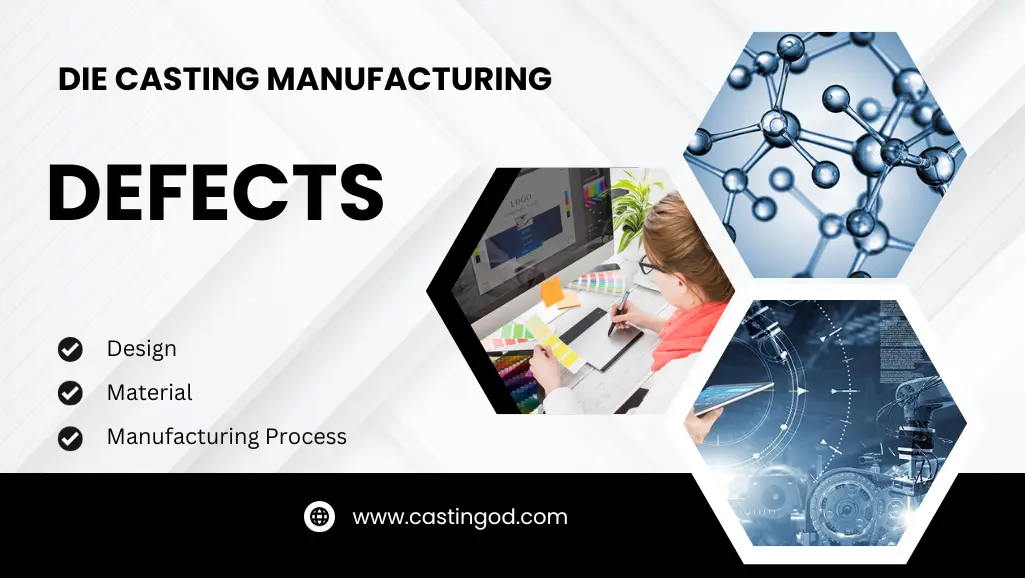When you think of manufacturing in die casting, it means converting a raw material into a finished product with high productivity. Production process and productivity are 2 different definitions. Production means trying to produce. Productivity means trying to produce with minimum material energy and minimum effort.
So, in this topic, we will try to cover design for manufacturing in die casting, which is in a short called DFM. So, for design for manufacturing definition, we will see:
- The purpose of DFM,
- Design flow of DFM.
DFM implementation techniques are designed for manufacturing and maintainability. So, these are some things which are this is a very generic discussion, this you can fit all these discussions with respect to composites also.
Why do we need to have a design for manufacturing?

The defects or quality Problems in a product are caused by 3 things: bad design, bad material choice. I also explained to you the weightage given for each property. In reality, there will normally be 2 or 3 different properties which are playing an important role.
Towards the outcome of the product to keep the customer satisfied. The last thing is choosing of wrong manufacturing process.
For example, if somebody comes and says I would like to make a shaft of polymer material for example. So, they say I want a diameter of 10 millimeters. So, if the possibilities are one, you can try to do it by machining.
For instance, I take 12 mm, 14 mm, or 16 mm rod polymer rod, and then I start doing machining, trying to reduce the diameter and bring it to 10. That is one possibility.
The second possibility is I tried to extrude. In extrusion, what happened was that I tried to put everything in the barrel. Then, I try to pressurize and push out through a die and get the required diameters. So, here, I do not waste material. The material, which is put as the raw material itself, I get it is as output I exactly make ten.
How to achieve sustainable die casting?

So, through this process also, you can try to make a polymer rod. So, if you see these 2 processes, both these processes, the outcome is achieved. But in the first process, you have a lot of scrap generating, which is not accepted Today when you talk about sustainable manufacturing.
The first one is commonly used for small back-size quantities, and the extrusion process is always looking forward to mass production. And here, in mass production, the die cost is very high.
So, in order to take out the die cost, they always try to look for mass production; the component price also comes down drastically, and it is also a very good process as far as the environment is concerned.
What happens if we choose the wrong manufacturing process?
So, here you are choosing a manufacturing process, and when you choose the wrong manufacturing process. In extrusion, what happens? The load is uniformly distributed; that means, say, the grain size and the defects are all taken care of, and the output you get is of very high quality in terms of strength.
Whereas when you do machining, you will have on the surface a lot of compressive stresses getting induced, but at the core, you are not pretty sure what is there. So, if we make a wrong choice of manufacturing process, that will also lead to a defective or a quality problem.
So, defects are to be minimized in order to make a customer very happy. So, defects or quality problems in the product are caused by 3 things: bad design; that is why I say that you understand what the customer wants, you decide the orientation and try to get what you want best.
Three Things That Can Destroy the Manufacturing Process In Die Casting

- Bad design
- Bad material choice
- A wrong manufacturing process will always lead to defective or quality problem-induced products.
Any incorrect design product will also result in a quality problem, despite having chosen the right material and the right or good manufacturing process. Even though I made 2 things good and 2 things, I achieved the best.
But the first thing is the design; if I make it not correct, or instead of a circular beam, I put a square beam, or instead of a shaft, I truss, I try to make something else.
So, then what happens is the material is chosen based on the design the manufacturing is chosen based on the design.
Today, there is a concept called concurrent engineering. The design engineer, material, and expert manufacturing experts all sit together to look at the customer’s requirements, and then, right from the conceptual stage, they are all involved.
So that they do not make any glaring mistakes to get the product very fast. Today, the biggest challenge, as I have told you earlier, is product life cycle reduction. How quickly can you come out with the product to make the customer happy?
Defects in Die Casting Design Also Impact The Production Cost
See, the occurrence of these defects is caused by several factors inherently in the design, in it not only increases the production cost. It increases the cost of the product, and also it reduces the quality problems. It also decreases the product quality.
So, the cost is directly proportional to the design choice, material selection, and manufacturing process. The common design problems include loosening parts. Many times, when on the bicycle the most, the most occurring problem is always from the pedal.
Example 1 of Cost In Die Casting
So, in the pedal, what happens? You have a screw, and you have a nut, and based upon the vibrations encountered in a cycle, this nut gets uns the nut, and the bolt assembly tries to get loosened. So, after lead time, one of the parts fails, and because of the pedal failure, many times, a customer stops using an entire bicycle. The cost of the nut and bolt assembly may be around about 10 dollars.
2nd Example Of Die casting cost
For another example, let me take you we buy a pair of pants which cost around about thousand dollars. The cost of the zip which is involved in a pant may be 5 percent of the entire cost or 2 percent of the entire cost. But if there is a bad zip, the entire pant fails.
Because of the bad zip, the company loses it is phase value. So, here is what has happened. There is a problem. So, this is a quality problem or a product quality problem, whatever you say. So, here, if we do not make a proper choice either in design or in choosing material, then we will have a design failure very fast.
So, the common design problems include loosening parts, which I told you is a cycle example rattling. The vibration cost Today. We talk about smart cars running cars, then parts not aligned properly.
- Tightened parts
- Missing parts
- Labor-intensive manufacturing assembly, etcetera.
If you see, basically, design is the important terminology. Design leads a bad design leads to bad material, and a bad material may lead to wrong production methods. So, these are the pushing need that leads to design for manufacturing.
In design for manufacturing, the definition, if you want to see, can be defined as a practice for designing products, keeping manufacturing in mind. Because just doing a design without keeping a manufacturing, then it does not lead anywhere.
Summary

Whenever you design a die-casting part, you should keep in mind that this can be converted into a product. So, if you want to convert into a product, we always have to manufacture the product. So, design for manufacturing is defined as the practice of designing products, keeping manufacturing in mind.








